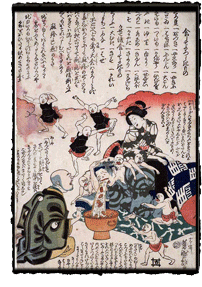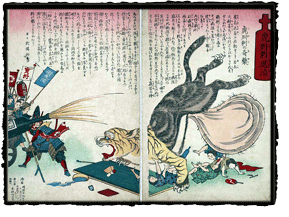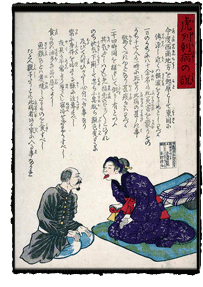|
Contagious Disease
Page 3 of 3
 Another image, by the artist Yoshimori, reveals a certain tension between traditional practices
and attitudes toward modern medicine.
The print shows a man vomiting coins into a metal bowl, as his daughter
and a doctor attend him. In a lengthy
inscription, the man complains that his "purse is constantly drained for
medicine and doctor's fees. I threw up
money again. If I vomit nothing but
money, can I recover from measles today?" Another image, by the artist Yoshimori, reveals a certain tension between traditional practices
and attitudes toward modern medicine.
The print shows a man vomiting coins into a metal bowl, as his daughter
and a doctor attend him. In a lengthy
inscription, the man complains that his "purse is constantly drained for
medicine and doctor's fees. I threw up
money again. If I vomit nothing but
money, can I recover from measles today?"
The doctor agrees that if the medicine is taken faithfully he will recover, and
that after all, "medicine's effect depends on money." As the man vomits, a crew of tiny figures —
the "good foods," their facial features rendered as characters for daikon or yakifu (wheat gluten) — clamber over the body and seem to
remonstrate with the doctor. Measles — personified as tiny figures wearing
black aprons, their features made up of the characters ハシカ,
or hashika — gesture impotently
above. At the top of the print are
listed the good foods, as well as other helpful comments and diagnostic tips.
 The notion that certain foods could
be beneficial in surviving the disease runs through many of the hashika-e. Perhaps the most direct evocation of this
idea is a charming print by Yoshifuji that portrays the measles god as
Shūtendōji, an ogre famed for his physical strength. In this scene, the strong man, covered with
rashes and with a mane of wild black hair, is carried aloft on a straw pallet
by a crew of "foods" — an orange, wheat gluten or tofu, along with labeled food
containers and packages serving as "heads" atop human bodies. The notion that certain foods could
be beneficial in surviving the disease runs through many of the hashika-e. Perhaps the most direct evocation of this
idea is a charming print by Yoshifuji that portrays the measles god as
Shūtendōji, an ogre famed for his physical strength. In this scene, the strong man, covered with
rashes and with a mane of wild black hair, is carried aloft on a straw pallet
by a crew of "foods" — an orange, wheat gluten or tofu, along with labeled food
containers and packages serving as "heads" atop human bodies.
The scene is meant to connote a Shinto festival, in which the kami (spirits) are paraded through the streets on portable carts (mikoshi) so that community members may
worship them and receive blessings. Furthering the connection are the stack of
round kagami mochi (rice cakes) and gohei (paper pendants) flanking the
ogre, both Shinto emblems that mark him as a god propitiated by offerings. In the foreground of the print stands a
doctor, his head a container marked "drugs," a fan decorated with two coins in
his hand. In the adjacent text, he
exhorts the foods to carry off the disease.
As in the previous example, there is the sense that money, drugs, and doctors are
useless at best without proper attention to diet. However, here the connection between the
foods' properties — their intrinsic purity or impurity — and Shinto belief is
made explicit.
Cholera
Cholera is thought to
have first entered Japan in
1822, by foreign ships entering through the port of Nagasaki. The first epidemic was limited to western
Japan, but in 1858, four years after Commodore Matthew Perry forced the
Japanese government to open additional ports to Western trade, a second, more
widespread epidemic spread as far east as Edo. The disease struck again and
again in the decades to follow. The disease was known as korori (sudden death) or mikka
korori (three-day death): causing severe diarrhea and dehydration, cholera
quickly killed its victims.
 The rapid spread and
ferocity of the disease led to its association with the tiger, and so the
Japanese character for tiger is used in writing the word korori, as well as in the Japanized version, korera, of the word cholera.
Tigers are often featured in prints dealing with the disease. The rapid spread and
ferocity of the disease led to its association with the tiger, and so the
Japanese character for tiger is used in writing the word korori, as well as in the Japanized version, korera, of the word cholera.
Tigers are often featured in prints dealing with the disease.
An 1886 print in the
collection depicts a lunging tiger that knocks a man off his sickbed, as his enormously engorged scrotum sweeps down to clobber three unwitting caregivers.
At left, soldiers spray the tiger with a large bottle, mounted like a cannon on a wheeled cart.
 The liquid is carbolic acid, or phenol, which
was a disinfectant considered effective in warding off the disease. In a print from 1877, this fluid is unleashed
upon a sword-wielding demon by the "prevention squad," a crowd of soldiers in
Western-style uniforms. The liquid is carbolic acid, or phenol, which
was a disinfectant considered effective in warding off the disease. In a print from 1877, this fluid is unleashed
upon a sword-wielding demon by the "prevention squad," a crowd of soldiers in
Western-style uniforms.
 An American doctor, D.B. Simmons, promoted the use of
carbolic acid in Japan. Working at Juzen
Hospital in Yokohama, Simmons began the practice of
disinfecting patients with carbolic acid and quarantining them to slow the
spread of the disease. It seems likely that Simmons is the balding Western man
shown inspecting the outstretched tongue of a Japanese woman in an 1877 print
titled "The Story of Cholera." The text above the figures describes the
rapid spread of the disease, its often fatal effects, and some recommendations
for patient care. An American doctor, D.B. Simmons, promoted the use of
carbolic acid in Japan. Working at Juzen
Hospital in Yokohama, Simmons began the practice of
disinfecting patients with carbolic acid and quarantining them to slow the
spread of the disease. It seems likely that Simmons is the balding Western man
shown inspecting the outstretched tongue of a Japanese woman in an 1877 print
titled "The Story of Cholera." The text above the figures describes the
rapid spread of the disease, its often fatal effects, and some recommendations
for patient care.
|
|
View by Theme
|

